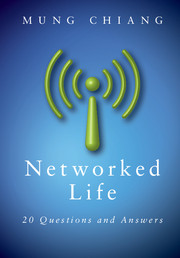Book contents
- Frontmatter
- Contents
- Preface
- Acknowledgements
- Roadmap
- 1 What makes CDMA work for my smartphone?
- 2 How does Google sell ad spaces?
- 3 How does Google rank webpages?
- 4 How does Netflix recommend movies?
- 5 When can I trust an average rating on Amazon?
- 6 Why does Wikipedia even work?
- 7 How do I viralize a YouTube video and tip a Groupon deal?
- 8 How do I influence people on Facebook and Twitter?
- 9 Can I really reach anyone in six steps?
- 10 Does the Internet have an Achilles' heel?
- 11 Why do AT&T and Verizon Wireless charge me $10 a GB?
- 12 How can I pay less for each GB?
- 13 How does traffic get through the Internet?
- 14 Why doesn't the Internet collapse under congestion?
- 15 How can Skype and Bit Torrent be free?
- 16 What's inside the cloud of iCloud?
- 17 IPTV and Netflix: How can the Internet support video?
- 18 Why is WiFi faster at home than at a hotspot?
- 19 Why am I getting only a few % of the advertised 4G speed?
- 20 Is it fair that my neighbor's iPad downloads faster?
- Index
- Notes
3 - How does Google rank webpages?
Published online by Cambridge University Press: 05 November 2012
- Frontmatter
- Contents
- Preface
- Acknowledgements
- Roadmap
- 1 What makes CDMA work for my smartphone?
- 2 How does Google sell ad spaces?
- 3 How does Google rank webpages?
- 4 How does Netflix recommend movies?
- 5 When can I trust an average rating on Amazon?
- 6 Why does Wikipedia even work?
- 7 How do I viralize a YouTube video and tip a Groupon deal?
- 8 How do I influence people on Facebook and Twitter?
- 9 Can I really reach anyone in six steps?
- 10 Does the Internet have an Achilles' heel?
- 11 Why do AT&T and Verizon Wireless charge me $10 a GB?
- 12 How can I pay less for each GB?
- 13 How does traffic get through the Internet?
- 14 Why doesn't the Internet collapse under congestion?
- 15 How can Skype and Bit Torrent be free?
- 16 What's inside the cloud of iCloud?
- 17 IPTV and Netflix: How can the Internet support video?
- 18 Why is WiFi faster at home than at a hotspot?
- 19 Why am I getting only a few % of the advertised 4G speed?
- 20 Is it fair that my neighbor's iPad downloads faster?
- Index
- Notes
Summary
A Short Answer
Now we turn to the other links you see on a search-result webpage; not the ads or sponsored search results, but the actual ranking of webpages by search engines such as Google. We will see that, each time you search on www.google.com, Google solves a very big system of linear equation to rank the webpages.
The idea of embedding links in text dates back to the middle of the last century. As the Internet scaled up, and with the introduction of the web in 1989, the browser in 1990, and the web portal in 1994, this vision was realized on an unprecedented scale. The network of webpages is huge: somewhere between 40 billion and 60 billion according to various estimates. And most of them are connected to each other in a giant component of this network. It is also sparse: most webpages have only a few hyperlinks pointing inward from other webpages or pointing outward to other webpages. Google search organizes this huge and sparse network by ranking the webpages.
More important webpages should be ranked higher. But how do you quantify how important a webpage is? Well, if there are many other important webpages pointing towards webpage A, A is probably important. This argument implicitly assumes two ideas:
• Webpages form a network, where a webpage is a node, and a hyperlink is a directed link in the network: webpage A may point to webpage B without B pointing back to A.
We can turn the seemingly circular logic of “important webpages pointing to you means you are important” into a set of equations that characterize the equilibrium (a fixed-point equilibrium, not a game-theoretic Nash equilibrium) in terms of a recursive definition of “importance.” This importance score will then act as an approximation of the ultimate test of search engines: how useful a user finds the search results.
- Type
- Chapter
- Information
- Networked Life20 Questions and Answers, pp. 44 - 60Publisher: Cambridge University PressPrint publication year: 2012



